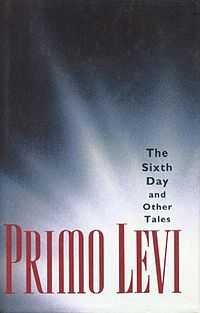The Sixth Day and Other Tales
|
Hardback cover - published by Summit Books. | |
| Author | Primo Levi |
|---|---|
| Original title | Vizio di forma and Storie naturali |
| Translator | Raymond Rosenthal |
| Country | Italy |
| Language | Italian |
| Genre | Short stories |
| Publisher | Summit |
Publication date | 1990 |
| Media type | Print (Hardcover) |
| Pages | 222 |
| ISBN | 0-671-62617-5 |
| OCLC | 21372291 |
| 853/.914 20 | |
| LC Class | PQ4872.E8 A6 1990 |
The Sixth Day and Other Tales, written by Primo Levi, is a collection of short stories, originally published in Storie naturali and Vizio di forma. Unlike the author's earlier and better-known works, these stories may be considered science fiction.
Contents
- The Mnemogogues
A doctor collects the scents of past places and events.
- Angelic Butterfly
Are humans trapped in the pupal stage? If so what happens when they pupate?
- Order on the Cheap
NATCA’s Mr Simpson shows off the Mimer. Like the replicator from Star Trek, anything can be reproduced.
- Man’s Friend
Tapeworms communicate through patterns on their bodies. They are aware they live inside us.
- Some Applications of the Mimer
Gilberto duplicates his wife. But the two Emmas slowly develop as different women.
- Versamina
The drug turns pain into pleasure. The consequence? People will hurt themselves.
- The Sleeping Beauty in the Fridge: A Winter’s Tale
Peter defrosts Patricia regularly. Sometimes for special events, sometimes for her regular checkups. But also sometimes for his own reasons. Patricia has been in the deep freeze for over a hundred years, but can stand it no more. She recruits Baldur to help her escape.
- The Measure of Beauty
A NATCA device for the objective measurement of beauty. But does it work? Of course it can be made to show the owner is beautiful.
- Full Employment
Simpson learns to communicate with the bees who help him to communicate with other insects. He enters into deals with them. Dragonflies pick berries for him, ants clean his garden, they can also manufacture small electronic components and help with microsurgery. But someone arranges for the eels to smuggle drugs.
- The Sixth Day
The committee agonises over how to design the human. But after all their argument management imposes an arbitrary design.
- Retirement Fund
NATCA develop something resembling a virtual reality set, but it replays the experiences that someone else recorded. Their elation and excitement are in the playback. It is, of course, addictive.
- Westward
Why do lemmings march to the sea? Researchers find out it is not hunger as is widely thought, but chemical. A form of alcohol is found that will suppress the desire for suicide.
- Seen From Afar
Aliens watch our planet, they cannot see the detail, but try to guess what things are and why the things they observe occur. Why are there streams of white and red lights in some places when darkness falls. Why do those large creatures (ships) travel in straight lines.
- The Hard-Sellers
They came to him to convince him to be born. They show him all the advantages of being alive, but he is sceptical. They say he is needed in the world of the living.
- Small Red Lights
Everything in his life is governed by red lights, thousands of them.
- For a Good Purpose
The telephone network develops intelligence when it is connected to the French and German networks. Slowly it experiments with its powers.
- Psychophant
A device creates an object that symbolises the person who touches it.
- Recuenco:The Nurse
The starving have their mythology about the creature in the sky that comes to feed them.
- Recuenco:The Rafter
The team on board the aircraft that delivers the food to the starving have their mythology about the recipients.
- His Own Blacksmith: To Italo Calvino
He can remember everything, even the memories of his ancestors, all the way back to when they first developed self-awareness. He sees that our development ceased once we had learned to use tools.
- The Servant
The story of a golem.
- Mutiny: To Mario Rigoni Stern
The garden has a mind of its own.
- Excellent is the Water
What happens when the water’s viscosity begins to creep up. All life is affected.
| ||||||||||||||||||||||||||
